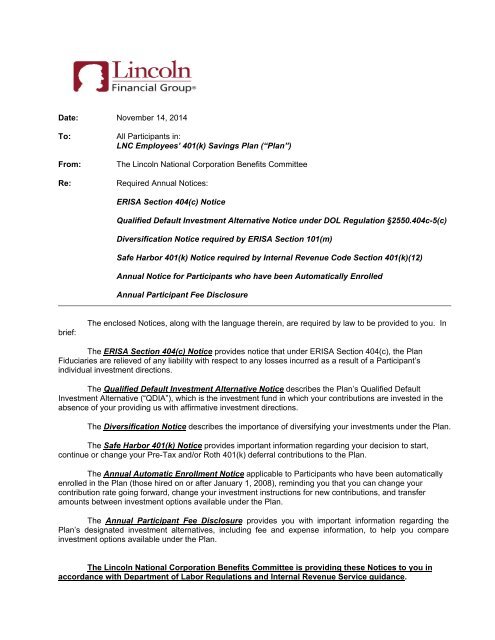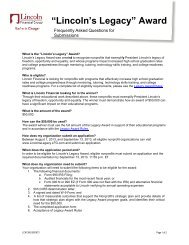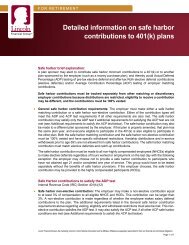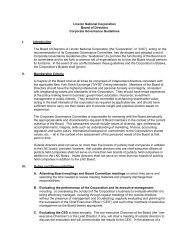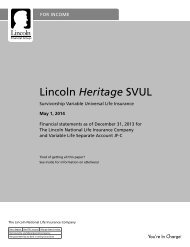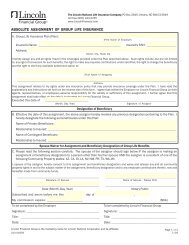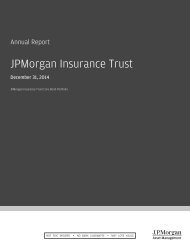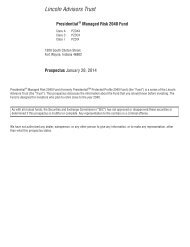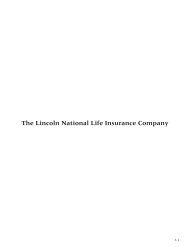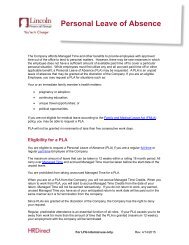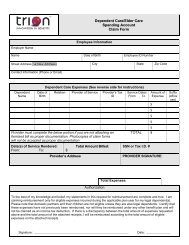LNC Employees' 401(k) - Lincoln Financial Group
LNC Employees' 401(k) - Lincoln Financial Group
LNC Employees' 401(k) - Lincoln Financial Group
Create successful ePaper yourself
Turn your PDF publications into a flip-book with our unique Google optimized e-Paper software.
Date: November 14, 2014<br />
To:<br />
From:<br />
Re:<br />
All Participants in:<br />
<strong>LNC</strong> Employees’ <strong>401</strong>(k) Savings Plan (“Plan”)<br />
The <strong>Lincoln</strong> National Corporation Benefits Committee<br />
Required Annual Notices:<br />
ERISA Section 404(c) Notice<br />
Qualified Default Investment Alternative Notice under DOL Regulation §2550.404c-5(c)<br />
Diversification Notice required by ERISA Section 101(m)<br />
Safe Harbor <strong>401</strong>(k) Notice required by Internal Revenue Code Section <strong>401</strong>(k)(12)<br />
Annual Notice for Participants who have been Automatically Enrolled<br />
Annual Participant Fee Disclosure<br />
brief:<br />
The enclosed Notices, along with the language therein, are required by law to be provided to you. In<br />
The ERISA Section 404(c) Notice provides notice that under ERISA Section 404(c), the Plan<br />
Fiduciaries are relieved of any liability with respect to any losses incurred as a result of a Participant’s<br />
individual investment directions.<br />
The Qualified Default Investment Alternative Notice describes the Plan’s Qualified Default<br />
Investment Alternative (“QDIA”), which is the investment fund in which your contributions are invested in the<br />
absence of your providing us with affirmative investment directions.<br />
The Diversification Notice describes the importance of diversifying your investments under the Plan.<br />
The Safe Harbor <strong>401</strong>(k) Notice provides important information regarding your decision to start,<br />
continue or change your Pre-Tax and/or Roth <strong>401</strong>(k) deferral contributions to the Plan.<br />
The Annual Automatic Enrollment Notice applicable to Participants who have been automatically<br />
enrolled in the Plan (those hired on or after January 1, 2008), reminding you that you can change your<br />
contribution rate going forward, change your investment instructions for new contributions, and transfer<br />
amounts between investment options available under the Plan.<br />
The Annual Participant Fee Disclosure provides you with important information regarding the<br />
Plan’s designated investment alternatives, including fee and expense information, to help you compare<br />
investment options available under the Plan.<br />
The <strong>Lincoln</strong> National Corporation Benefits Committee is providing these Notices to you in<br />
accordance with Department of Labor Regulations and Internal Revenue Service guidance.
ERISA 404(c) NOTICE<br />
<strong>LNC</strong> Employees’ <strong>401</strong>(k) Savings Plan<br />
LNL Agents’ <strong>401</strong>(k) Savings Plan<br />
LNL Money Purchase Plan<br />
LNL ABGA Money Purchase Plan<br />
The above plans are intended to be plans described in Section 404(c) of the Employee Retirement<br />
Income Security Act of 1974, as amended, and Title 29 of the DOL Regulation §2550.404c-1. This means<br />
that the <strong>Lincoln</strong> National Corporation Benefits Committee and other fiduciaries of the plans may be relieved of<br />
liability for any losses that are the direct and necessary result of investment instructions given by participants<br />
or beneficiaries of the above plans.<br />
Voting Rights in <strong>LNC</strong> Stock Fund<br />
If any portion of your plan account is invested in the <strong>LNC</strong> Stock Fund, you will have the opportunity to<br />
direct the Trustee on how to vote your <strong>LNC</strong> Stock Fund shares at any regular or special meeting of the<br />
Company’s shareholders. Before the meeting, you will be provided with materials relating to the exercise of<br />
voting, tender or similar rights with respect to the <strong>LNC</strong> Stock Fund held in your plan account. The Company<br />
will not know how you voted. Your voting decision will be kept confidential. The Trustee will vote shares for<br />
which directions have not been received in the same proportion as the shares for which directions have been<br />
received.
QUALIFIED DEFAULT INVESTMENT ALTERNATIVE NOTICE<br />
<strong>LNC</strong> Employees’ <strong>401</strong>(k) Savings Plan<br />
LNL Agents’ <strong>401</strong>(k) Savings Plan<br />
LNL Money Purchase Plan<br />
LNL ABGA Money Purchase Plan<br />
<strong>Lincoln</strong> National Corporation or The <strong>Lincoln</strong> National Life Insurance Company have adopted the above taxqualified<br />
retirement plans [<strong>401</strong>(k) and Money Purchase Plans] to help you attain financial security during your<br />
retirement years. As a participant in one or more of these plans, you decide how your retirement plan dollars will<br />
be invested. If you do not make an investment election, your contributions and the contributions made on your<br />
behalf will be invested in the applicable plan’s Qualified Default Investment Alternative (“QDIA”). Keep this<br />
disclosure with your Summary Plan Description and other retirement plan documents.<br />
The QDIA for the above-referenced plans is the SSgA Target Retirement Fund (a target-date fund) that most<br />
closely matches the year you attain age 65.<br />
This QDIA notice:<br />
Describes when the QDIA will be used<br />
<br />
<br />
<br />
Provides details regarding the QDIA selected<br />
Outlines your right to direct the investment of your plan dollars to other investments available in the plan or to<br />
elect not to have contributions withheld from your pay, if applicable<br />
Explains where additional information can be obtained regarding those additional investment alternatives<br />
When the default fund will be used under the Employees’ <strong>401</strong>(k) Plan:<br />
You have made a salary reduction election without an investment election in the <strong>401</strong>(k) Plan<br />
<br />
<br />
An employer discretionary contribution has been made on your behalf but you have not provided investment<br />
elections<br />
The plan contains an automatic enrollment feature and you did not make an investment election during the<br />
notice period. (6.0% of your eligible compensation will be contributed to the plan as an elective contribution.)<br />
When the default fund will be used under the Agents’ Plans:<br />
You have made compensation reduction elections without an investment election in the Agents’ <strong>401</strong>(k) plan<br />
<br />
A company contribution has been made on your behalf but you have not provided investment elections (Money<br />
Purchase Plan)<br />
The <strong>Lincoln</strong> National Corporation Benefits Committee has chosen a target-date fund that most closely<br />
matches the year you attain age 65 as the QDIA.<br />
The QDIA as listed below is the appropriate time-based fund based on the year you attain age 65. Each fund contains<br />
a combination of fixed income, bond-based and equity-based funds and targets a five-year period that contains the<br />
year in which you attain age 65.<br />
Fund Name Birth Year Retirement Year Fees<br />
SSgA Target Retirement Income Fund 1942 and before 2007 and before 0.17%<br />
SSgA Target Retirement 2015 Fund 1948-1952 2013-2017 0.17%<br />
SSgA Target Retirement 2020 Fund 1953-1957 2018-2022 0.17%<br />
SSgA Target Retirement 2025 Fund 1958-1962 2023-2027 0.17%<br />
SSgA Target Retirement 2030 Fund 1963-1967 2028-2032 0.17%<br />
SSgA Target Retirement 2035 Fund 1968-1972 2033-2037 0.17%<br />
SSgA Target Retirement 2040 Fund 1973-1977 2038-2042 0.17%<br />
SSgA Target Retirement 2045 Fund 1978-1982 2043-2047 0.17%<br />
SSgA Target Retirement 2050 Fund 1983-1987 2048-2052 0.17%<br />
SSgA Target Retirement 2055 Fund 1988 and after 2053 and after 0.17%
Investment Objective: The SSgA Target Retirement Funds (the “Funds”) seek an investment return that<br />
approximates, as closely as practicable, before expenses, the performance of a custom benchmark index (the<br />
“Index”) over the long term.<br />
Investment Strategy: Each Fund seeks to achieve its objective by investing in a set of underlying SSgA collective<br />
trust funds representing various asset classes. Each Fund (other than the SSgA Target Retirement Income Fund)<br />
is managed to a specific retirement year (target date) included in its name. Over time, the allocation to asset<br />
classes and funds change according to a predetermined “glide path.” (The glide path represents the shifting of<br />
asset classes over time and does not apply to the Income Fund.) Each Fund’s asset allocation will become more<br />
conservative as it approaches its target retirement date. This reflects the need for reduced investment risks as<br />
retirement approaches and the need for lower volatility of a portfolio, which may be a primary source of income<br />
after retiring. The allocations reflected in the glide path do not reflect tactical decisions made by SSgA to<br />
overweight or underweight a particular asset class based on its market outlook but rather management of each<br />
fund’s strategic allocation according to its glide path and applicable benchmark. Each Fund attempts to closely<br />
match the characteristics and returns of its custom benchmark as opposed to any attempts to outperform this<br />
benchmark. Once a Fund reaches its target retirement date, it will begin a five-year transition period to the SSgA<br />
Target Retirement Income Fund resulting at the end of that five-year period in an allocation to stocks and real<br />
estate that will remain fixed at approximately 35% of assets. The remainder of the Fund will be invested in fixedincome<br />
securities.<br />
Risk and Return Characteristics: SSgA measures and adjusts each Fund’s risk exposure over time given the<br />
Fund’s target retirement date. SSgA monitors the overall risk of the Fund, in order to avoid unintended risk related<br />
to the Fund’s target retirement date or other investment time horizon. SSgA attempts to manage risk by, among<br />
other things, monitoring asset allocations closely, maintaining diversification, and performing ongoing investment<br />
reviews.<br />
By investing in a target-date fund, you assume the same types of risks, either directly or indirectly, as investing in<br />
equity funds and fixed income funds. For assets allocated to equity, the primary risk is that the value of the equity<br />
will fluctuate. These fluctuations could cause the value of a target-date fund’s equity investment and therefore the<br />
value of the target-date fund held to fluctuate, and you could lose money.<br />
For assets allocated to fixed income, the primary risks are interest rate risk and credit risk. Interest rate risk is the<br />
risk that the value of the debt obligations held by the target-date fund will fluctuate with changes in interest rates.<br />
Credit risk is the risk that the issuer of the debt obligation will be unable to make interest or principal payments on<br />
time. The value of the debt obligations held by a target-date fund will fluctuate with the changes in the credit<br />
ratings of the debt obligations held.<br />
Because the target-date fund invests in the shares of funds, the target-date fund indirectly invests in the same<br />
investments as listed for the various underlying funds. For a more detailed description of the various types of<br />
instruments in which the underlying funds may invest and their associated risk, please refer to each of the<br />
underlying fund’s prospectus.<br />
Making investment elections and additional information<br />
If you are in the QDIA, you may, at any time, choose other investment options without financial penalty. However,<br />
ongoing investment and account fees may apply. Refer to the prospectus for each fund for complete<br />
information on risks, fees, and expenses.<br />
Customer Service Center<br />
You may make changes in your investment instructions as well as view information for additional investment<br />
options in the plan by going online at <strong>Lincoln</strong><strong>Financial</strong>.com. The participant website will walk you through the<br />
steps to make changes to your account and display the effective date of your transaction. You may also contact<br />
the <strong>Lincoln</strong> Alliance ® Customer Service Center at 800-234-3500 from 8:00 a.m. to 8:00 p.m. Eastern Time,<br />
Monday through Friday. If you call before 4:00 p.m. Eastern Time, on a business day, your transaction will be<br />
effective at the close of that day. If you call after 4:00 p.m. Eastern Time, your transaction will be effective at the<br />
close of the following business day.<br />
Please note: The New York Stock Exchange closes for trading at 4:00 p.m. Eastern Time on most business<br />
days. Therefore, transactions we receive before market close will be assigned that day’s closing unit price.<br />
Transactions we receive after market close, or on a weekend or holiday, will be assigned the closing unit price for<br />
the next business day. Access may be subject to system availability.
DIVERSIFICATION NOTICE<br />
<strong>LNC</strong> Employees’ <strong>401</strong>(k) Savings Plan<br />
LNL Agents’ <strong>401</strong>(k) Savings Plan<br />
LNL ABGA Money Purchase Plan<br />
The Pension Protection Act of 2006 (the “PPA”) gives participants in retirement plans that offer<br />
company stock as an investment option, the freedom to make their own investment choices by limiting<br />
restrictions placed on investments in company stock. The above Plans offer company stock as an investment<br />
option (the “<strong>LNC</strong> Stock Fund”). Each Plan complies with the PPA requirements by allowing you to move any<br />
amounts invested in the <strong>LNC</strong> Stock Fund, into another investment option available under the Plan at any time.<br />
However, in light of Congress’ concern for proper diversification, we want to take this opportunity to remind<br />
you of your ability to diversify your Plan accounts and the benefits of diversification.<br />
Diversification is a very important tool in managing your retirement assets. Diversification is the<br />
process of reducing risk by investing in several different types of investments instead of just one security,<br />
such as company stock. If your retirement account is invested in just one security, your account could<br />
experience large swings in value. It could increase greatly in value, or it could decrease greatly, too, including<br />
a total loss if employer bankruptcy were to occur. Basically, putting all of your money into one security may<br />
be too risky.<br />
To help achieve long-term retirement security, you should give careful consideration to the benefits of<br />
a well-balanced and diversified investment portfolio. Spreading your assets among different types of<br />
investments can help you achieve a favorable rate of return, while minimizing your overall risk of losing<br />
money. This is because market or other economic conditions that cause one category of assets, or one<br />
particular security, to perform very well often cause another asset category, or another particular security, to<br />
perform poorly. If you invest more than 20% of your retirement savings in any one company or industry, your<br />
savings may not be properly diversified. Although diversification is not a guarantee against loss, it is an<br />
effective strategy to help you manage investment risk.<br />
In deciding how to invest your retirement savings, you should take into account all of your assets,<br />
including any retirement savings outside of the Plan. No single approach is right for everyone because,<br />
among other factors, individuals have different financial goals, different time horizons for meeting their goals,<br />
and different tolerances for risk. Therefore, you should carefully consider the rights described in this Notice<br />
and how these rights affect the amount of money that you invest in company stock through the Plan.<br />
It is also important to periodically review your investment portfolio, your investment objectives, and<br />
the investment options under the Plan to help ensure that your retirement savings will meet your retirement<br />
goals.
2015 SAFE HARBOR <strong>401</strong>(k) NOTICE<br />
This Notice provides important information relating to your participation in the <strong>LNC</strong> Employees’ <strong>401</strong>(k)<br />
Savings Plan (“Plan”) for the plan year that begins January 1, 2015. This is an administrative notice required<br />
by law and has no impact on the Plan or the amount of contributions made to the Plan on your behalf. This<br />
Notice provides important information regarding your decision to start, continue or change your Pre-Tax<br />
and/or Roth <strong>401</strong>(k) contributions to the Plan.<br />
The Company adopted a safe harbor <strong>401</strong>(k) plan matching contribution formula effective January 1, 2008.<br />
The Company will make a matching contribution to the Plan on your behalf that equals $1.00 for every $1.00<br />
of eligible pay that you contribute, up to a maximum of 6% of your eligible pay, per payroll period. This<br />
matching contribution will satisfy the Internal Revenue Service’s safe harbor matching contribution<br />
requirement. To receive the maximum employer matching contribution, you must contribute at least 6% of<br />
your eligible pay to the Plan by payroll deduction on a payroll-by-payroll basis.<br />
Eligibility for Safe Harbor Matching Contribution. All eligible employees who make Pre-Tax and/or Roth<br />
<strong>401</strong>(k) contributions to the Plan will be eligible for the Company’s safe harbor matching contribution. All safe<br />
harbor matching contributions are made on a pre-tax basis – including those made with respect to Roth<br />
<strong>401</strong>(k) contributions, which are made on an after-tax basis.<br />
Eligible Pay. The eligible pay used for the safe harbor matching contribution is the same pay used for all<br />
Plan purposes: your basic compensation, certain bonuses, overtime pay, commissions and annual incentive<br />
pay.<br />
Additional Employer Contributions. All employees who are eligible to participate in the Plan will also<br />
receive a core contribution equal to 4% of eligible pay per payroll period. You are eligible for this core<br />
contribution whether or not you contribute to the Plan.<br />
You are also eligible for a transition contribution if you have met certain service requirements and if the<br />
combination of your age and years of vesting service—your “Points”—was at least equal to “46” as of<br />
December 31, 2007. You are eligible for this transition contribution whether or not you contribute to the Plan<br />
for a period of ten (10) years. Transition contributions will be discontinued after December 31, 2017.<br />
Please see your Summary Plan Description for more details about the Plan’s core and transition<br />
contributions, including a chart providing the transition contribution percentage for various “Points” totals.<br />
Participant Contributions. As a Plan participant, you may authorize the Company to withhold regular<br />
payroll deductions from your paycheck and to contribute the withheld amount to the Plan. You may elect to<br />
have up to 75% of your eligible pay withheld and contributed to the Plan per payroll period, up to certain IRS<br />
limits. For 2015, your aggregate contributions cannot exceed $18,000 (or $24,000 if you are catch-up<br />
contribution eligible). Active participants age 50 and older who meet certain plan and/or IRS limits are eligible<br />
to make additional “catch-up” contributions of up to $6,000 to the Plan in 2015. Your employee contributions<br />
and any corresponding earnings are always 100% vested.<br />
You may elect to make payroll deduction and catch-up contributions via phone or Internet through the Plan’s<br />
record keeper, the <strong>Lincoln</strong> Alliance ® program (“<strong>Lincoln</strong> Alliance”). You may change your payroll deduction<br />
at any time. Any change will be made effective as soon as administratively practicable (typically the<br />
first or second payroll after the change is made). You may stop your payroll deduction contributions at<br />
any time as well by contacting <strong>Lincoln</strong> Alliance by logging into your account on <strong>Lincoln</strong> Alliance’s website at:<br />
www.<strong>Lincoln</strong><strong>Financial</strong>.com, or through the <strong>Lincoln</strong> Alliance Customer Service Center at: 800 234-3500. This<br />
“stop” will take effect as soon as administratively practicable. If you stop making payroll deduction<br />
contributions, the employer matching contributions will also stop, but your core contributions and any<br />
applicable transition contributions will continue to be made on your behalf. You may resume payroll<br />
deduction contributions at any time by contacting <strong>Lincoln</strong> Alliance. Payroll deductions would resume as soon<br />
as administratively practicable (typically the first or second payroll after the change is made).
Vesting. The safe harbor matching contribution is always 100% vested. If you were employed on December<br />
31, 2007, you were 100% vested in your pre-2008 employer matching contributions. Transition contributions,<br />
if any, made on your behalf are also 100% vested. Core contributions are 100% vested after you have<br />
completed two years of vesting service. You are credited with a year of vesting service on each December<br />
31st on which you are employed by <strong>Lincoln</strong>.<br />
Distributions & Withdrawal Restrictions. Generally, you will not be able to receive a distribution from the<br />
Plan of your account balances (consisting of your participant contributions, employer contributions, and<br />
earnings and losses attributable to those contributions) until your employment terminates. However, you may<br />
be eligible to take a withdrawal of your vested account balances under certain circumstances or in the event<br />
of a financial hardship. In addition, once you attain age 59½, you may be eligible to withdraw your vested<br />
account balances. The safe harbor matching contribution described above may not be withdrawn until you<br />
terminate employment, or attain age 59½. You may not withdraw the safe harbor matching contribution as a<br />
hardship distribution.<br />
Making Participant Contributions Under the Plan. You may start or change your Pre-Tax and/or Roth<br />
<strong>401</strong>(k) contributions to the Plan at any time during the year through the <strong>Lincoln</strong> Alliance website at<br />
www.<strong>Lincoln</strong><strong>Financial</strong>.com or through the <strong>Lincoln</strong> Alliance Customer Service Center at 800 234-3500.<br />
For more information on the Plan and its features, refer to the Plan’s Summary Plan Description. Additionally,<br />
you may contact the <strong>Lincoln</strong> Alliance Customer Service Center at 800 234-3500 with any questions.<br />
Note:<br />
The Plan Administrator may, at its discretion, implement an automatic increase feature during the<br />
plan year to increase to 6% of eligible pay the deferral percentage of all eligible employees who are<br />
deferring less than that amount when the feature is implemented. If the Plan Administrator<br />
implements this feature, all eligible employees will receive advanced notice and have the opportunity<br />
to make an election to avoid being subject to the increase. Any eligible employee who is<br />
automatically increased will be able to change their deferral percentage at any time thereafter.
ANNUAL NOTICE<br />
TO<br />
AUTOMATICALLY ENROLLED PARTICIPANTS ONLY<br />
The <strong>LNC</strong> Employees’ <strong>401</strong>(k) Savings Plan (“Plan”) is a valuable tool to help you save for your future.<br />
Because saving for retirement is so important, new employees who are hired on or after January 1, 2008 are<br />
automatically enrolled into the Plan after 30 days of service.<br />
You are considered automatically enrolled in the Plan if you did not take affirmative action to enroll in the Plan<br />
and have not changed your investment percentage or investment option.<br />
Once you were automatically enrolled, contributions began to be deducted from your paychecks on a pre-tax<br />
basis and your contributions were automatically invested in the Plan as described below.<br />
6% of your eligible earnings on a per payroll period was contributed to the Plan, subject to Plan or<br />
IRS limits;<br />
100% of your contributions are invested in the Plan’s Qualified Default Investment Alternative<br />
(“QDIA”), the SSgA Target Retirement Fund (a target-date fund) that most closely matches the year<br />
you attain age 65; and<br />
The Company matched your contributions in an amount equal to $1.00 for every $1.00 you<br />
contributed, up to 6% of your eligible earnings, on a per payroll period basis. The Company also<br />
made core contributions in the amount of 4% of your eligible earnings on a per payroll period basis.<br />
You are 100% vested in your contributions and the Company matching contributions. You are vested in the<br />
Company core contributions after completion of 2 years of vesting service. You are credited with a year of<br />
vesting service on each December 31st on which you are employed by <strong>Lincoln</strong>.<br />
The fund fact sheets for the SSgA Target Retirement Funds, as well as the other Plan Investment Options,<br />
can be found on the <strong>Lincoln</strong> Alliance website at: www.<strong>Lincoln</strong><strong>Financial</strong>.com or<br />
www.lincolnfinancial.com/retirementinfocenter.<br />
If you were automatically enrolled and have taken no action, you can take the following action at any<br />
time:<br />
<br />
<br />
Change the 6% default contribution rate to a different percentage (from 1% to 75%—or opt out of<br />
participation altogether by electing “0%”),<br />
Direct your contributions into investments other than the QDIA option described above. Information<br />
about other Plan Investment Options is available on the <strong>Lincoln</strong> Alliance website at:<br />
www.<strong>Lincoln</strong><strong>Financial</strong>.com.<br />
As a Participant in the Plan, you may always change your contribution rate going forward, change your<br />
investment instructions for new contributions, and transfer amounts between Investment Options (subject to<br />
certain restrictions that may apply).<br />
To make changes to your current contribution percentage or to stop making contributions, access the <strong>Lincoln</strong><br />
Alliance website at www.<strong>Lincoln</strong><strong>Financial</strong>.com. You will need a user name and password to access your<br />
account. If you need assistance accessing the website or do not wish to make your elections online, you may<br />
contact the <strong>Lincoln</strong> Alliance Customer Service Center at 800 234-3500 for assistance.<br />
More information about the Plan can be found in the Plan’s Summary Plan Description. You may also call the<br />
<strong>Lincoln</strong> Alliance Customer Service Center at 800 234-3500 for assistance. Customer service representatives<br />
are available Monday-Friday, 8 a.m. to 8 p.m., Eastern Time to answer any questions.<br />
1455926 v 1


